I didn’t start out with a complete homeowners tool kit. Nor did my wife start out with all the handy appliances and gadgets in the kitchen. We started with the basics and added to our collections as the need arose and money allowed. This is how the average DIY homeowner starts out. The money you save on a project by doing it yourself helps offset the cost of adding a new tool to your collection. Then once you have that new tool you’re better prepared to take on other projects and repairs in the future. And so the cycle begins.
As a homeowner, you will always have maintenance items and minor repairs to make. A loose leg on a coffee table, hanging curtains, or a leaky faucet. Outside you might have to change the oil in your rototiller or replace the blades on your lawn mower. A simple thing like putting together the kids new swingset or adjusting the height of a bicycle seat all requires some basic hand tools.
In this article, we’ll put together a list of tools to help you get started on this adventure. I’d like to start by looking at a couple of strategies for adding new tools to your toolbox. Then we’ll look at some of the basic tools that every homeowner should have. I think you’ll soon see why you start with the basics and add to them over the course of many years. So if you’re just getting started on this journey and want some tips and advice from someone with 40 years of experience, please read along.
Strategies For Adding To Your Homeowners Tool Kit
Table of Contents
Whether you’re looking to make your first tool purchase or need to add something to the toolbox for an upcoming project, here are a few ways that have worked for me over the years. First I would like to highly suggest that when making tool purchases, stick with a good quality tool. They don’t have to be top of the line, but there are several companies out there that make good quality tools, with good warranties, and at a reasonable price. A tool purchase is truly an investment. If you buy good quality tools and use them properly, they will last a lifetime in the average DIY homeowner’s toolbox.
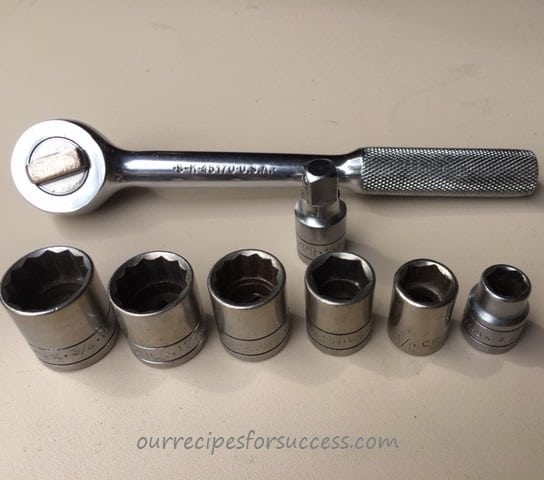
Gifts (Give and Receive)
The first tool I started out with was a small ⅜” drive socket set. My father gave them to me for Christmas, when I was first out of high school. It was a good quality set for the time (S&K) and I still have, and use, that set today. New or used, a good quality tool makes a great gift for someone starting out. Add a cordless drill to your own Christmas list. Drop the hint for a 10” Crescent wrench for Father’s Day. If it’s something you’d like or need, it’s a perfect time. And don’t forget the giving part. Tools make good gifts for the young adults in your family just getting started too. Like my socket set, they’ll be able to use them for years.
Garage Sales
We all know many garage sales can be full of “junk”. However, occasionally you can come across some treasures. Tools are no exception! As mentioned above, if used properly and cared for, old tools can provide years of use. And at a fraction of the cost of new ones. So be sure to check the bottom of some of those old boxes full of seemingly junk. There may be a gem hidden there.
A good quality tool is usually easy to spot if you’ve been around them and used them. I usually look for brands like Snap-On, MAC, SK, Williams, and Craftsman. They’ve all been around for a while and made good quality tools. There are some who say Craftsman tools aren’t as good as they used to be. However, if you can find some of the older Craftsman brand tools, they’re not a bad tool. There are other decent tool manufacturers, so next time you’re chatting with a mechanic or some old-timer ask them what brands they’ve had good luck with.
Planning For A Project
If you have a project you’ve decided to tackle, one of the most important things you can do is the planning. Research the repair or project so you understand the steps. Make sure you have the right parts or materials. And make sure you have the correct tools. For any project, these are your two biggest fiends. Research and planning! Well… and having the right tools.
For example, let’s say you decided to change the front brakes on your car. This isn’t a horrible job, but it typically requires a couple of different sized metric wrench and maybe a Torx wrench on some vehicles. Purchasing these items individually or in a small kit is a great way to start. You could easily pay $100 to $200 in labor to have the job done at a garage. I suggest using a smaller portion of that money to buy the tools needed to do the job yourself. Then you own the tools and are better prepared for your next repair project. Remember, tools are an investment!
I’ve saved time and money make home repairs for years. See how easy it is to replace a vehicle headlight bulb or to change your own oil. I’ve written articles on how to do both of these on my Chevy Silverado and you would be surprised at how few tools it takes to do both tasks. No more scheduling repair appointments or paying way to much for the job.
Tools Every Homeowners Toolkit Should Include
As a new homeowner, there are several essential tools you should have. That still doesn’t mean you have to buy them all at once, but the sooner you have them the more prepared you are for the unexpected.
In this article, we will be providing you with a few links to some products for pricing and informational purposes. We are required to let you know some of these links are “affiliate links”. This means if you click on a link and make a purchase, we could make a small commission, at no extra cost to you. This helps offset the cost of maintaining our website. Now, let’s get started.
Basic Hand Tools
Remember, this is not a complete list of tools you’ll need for every project or issue you run into. This list is of the most common tools that will allow you to make many home repairs. Add to this list as needed and share it with a friend or family member.
Hammers
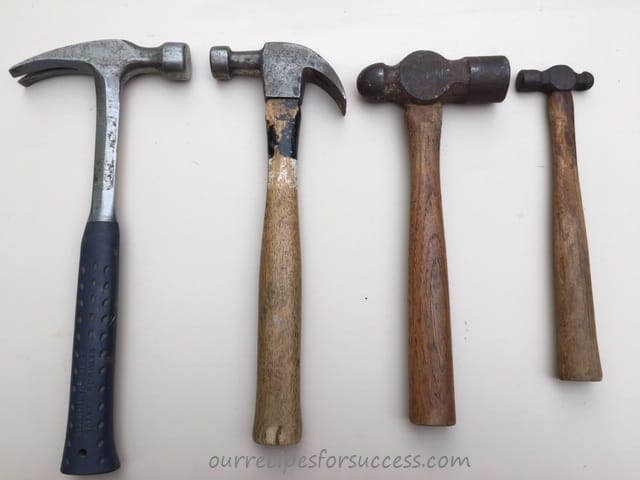
There are many different types of hammers, but the two you’ll want in your toolbox is a claw hammer and a ball peen hammer. The claw hammer is the one most everyone is familiar with. It’s used for driving nails in, pulling nails, and mainly used when working with wood. The ball peen hammer has a unique shape. Opposite the flat hammer end, it has a rounded end. The rounded end can focus more striking force on a smaller area. This is good for tapping on rusted, stuck bolts to help loosen them. They’re perfect for straightening a bent piece of metal. I recommend starting out with a 16-ounce hammer. They’re big enough to tackle most jobs around the house. Always wear safety glasses when using a hammer.
Screwdrivers
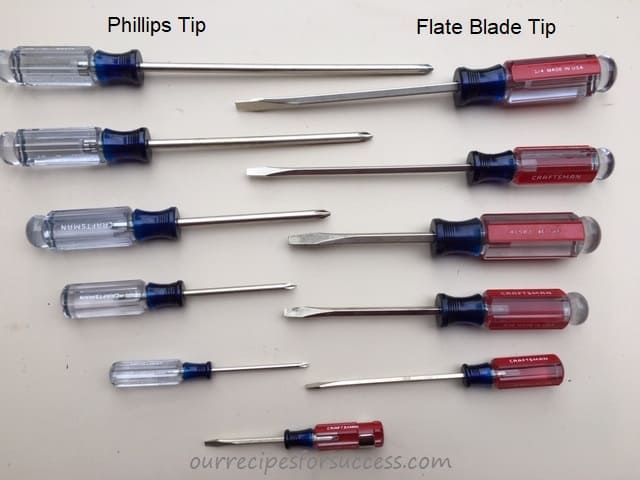
Screwdrivers come in two basic types, the Phillips and flat blade screwdrivers. This one’s pretty self-explanatory. Screws are everywhere in your home. You will need to tighten screws, remove screws and install screws on a routine basis. Both types of screwdriver come in multiple sizes and that’s because screws come in many sizes.
For this reason, screwdrivers are one of the tools I recommend purchasing in a packaged set. Most kits come in the common sizes and lengths you’ll need for around the house. You must use the proper sized screwdriver for the screw and keep good downward pressure on the screwdriver at all times. This helps prevent the dreaded stripped screw head!
Remember to stick with a good brand and use them properly. The biggest mistake made with screwdrivers is hitting them with a hammer or using them for prying. I know, everybody does it, but repeated and excessive use of this type is guaranteed to split the handles and break the tips. If you find yourself repeatedly using your screwdriver like this, you may want to look into chisels, punches and pry bars. Although they are not on my list of must-have tools for the beginning homeowners toolbox, you may benefit from owning them. It will save your screwdrivers.
Pliers
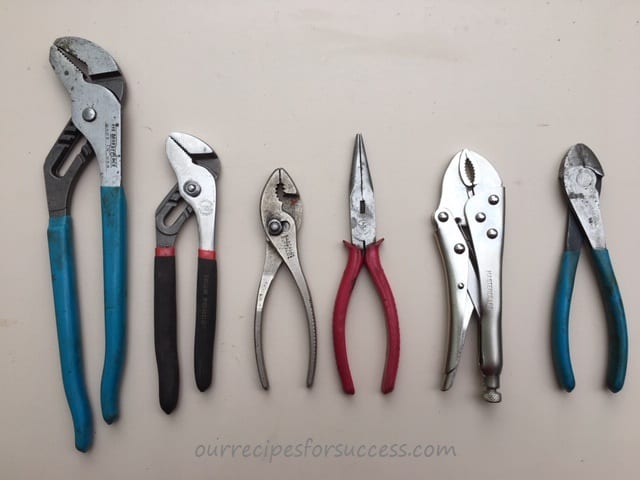
I’ve selected four of the basic types of pliers to add to your homeowner’s toolbox. With them, I think you’ll be able to tackle 95% of the jobs you’ll run into around the house. When it comes to that 5% just remember there are many different types, sizes, and variations of pliers out there. There’s probably something specific for the task that you can add to your collection. Over time I am fairly confident in saying you will add to this collection. With that said, I believe the five plier selections below can handle the 95% for you.
Groove Joint Pliers
Groove joint pliers are commonly called Channel Locks, which is a well-known, good quality tool. The design of these pliers provides superior gripping power compared to other types of pliers. The slip tongue in groove joints allow for multiple adjustment points, which maximizes the grip strength in every position. They are good for holding round items, like a pipe, as well as nuts and bolts. They are at the top of my plier list for a reason.
Slip Joint Pliers
These are a basic pair of pliers that are good for lighter gripping and holding tasks. The slip joint provides a two-position adjustment, which adds some flexibility. The design of this tool grips the item your holding in a straight line with the pliers. This works well for gripping, holding or pulling in a straight line.
Needle Nose Pliers
Just as the name implies the needle nose plier‘s jaws taper down to a narrow end. They are perfect to hold small parts and for reaching into tight spaces. They may not have the grip strength that other pliers have, but that’s not what they were designed for. Needle nose pliers could be in that 5% of the tasks mentioned above. They come in many sizes, some are very long, and others have angled jaws. If there’s something you’re having trouble reaching, check out some of the options available.
Locking Pliers
These pliers are often referred to as Vise-Grips, which is a good brand of tool. These pliers are typically adjustable by a knob at the end of the grips and when closed they lock in position. The adjustment allows you to increase or decrease the gripping power. With increased pressure, it can take some effort for the pliers to lock, but when they do the grip is solid.
Like the groove joint pliers, they are good for holding round items, like a pipe, as well as nuts and bolts. Their grip strength is much better and never gets tired. Locking pliers are also great for holding to pieces of material together. They too come in different sizes and options, so keep them in mind if you come across a unique gripping requirement.
Wire Cutters
Wire cutters fall into this category only by their basic design. They are commonly called diagonal cutters and do not grip at all, they only are intended to cut wire. You may be wondering why they have made my list. It’s simply because of the number of uses around the house. Obviously the cut wire, both electrical and baling wire, but there’s so much more they can be used to cut. Stems on artificial plants and flowers. Small decorative chains and cables. Cutting fencing. I’ve even trimmed down tomato cages.
To do some of the cutting mentioned above there are a couple of properties you’ll need in your wire cuttings. First, don’t go to small. You’ll be surprised what a larger set of wire cutters can handle. If you have smaller cutting needs, then add a second, smaller pair. The second thing is they have to be a good quality set of cutters. Good cutter jaws are made of hardened steel, which will hold an edge, cut better, and last longer. To make cutting easier open the cutter jaws fully, insert the wire (material) completely into the cutting jaws as far as it will go, and squeeze.
Adjustable End Wrench
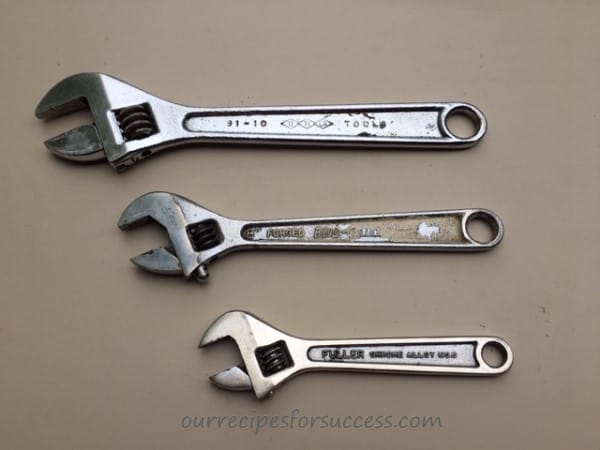
The adjustable end wrench is frequently called a Crescent wrench, which is yet another good quality tool manufacturer. They come in several sizes and can be adjusted to fit any nut or bolt. This is good because it doesn’t matter if it a U.S. standard SAE (Society of Automotive Engineering) nut or bolt or metric. Adjustable wrenches are great for a lot of quick fixes and adjustments.
The downside of the adjustable wrench is they are not well suited for working on tasks that require a lot of excessive torquing. The jaws can open slightly while torquing, which could allow the wrench to slip. This can damage the hexagonal head of the bolt or the nut. Another disadvantage an adjustable wrench has is it does not fit into tight spaces. Their jaws are bigger than a traditional wrench and cannot reach into some places. So, if you need to remove a rusty nut or a bolt in a tight location, it’s best to use one of the next two items on the list.
Combination Wrenches
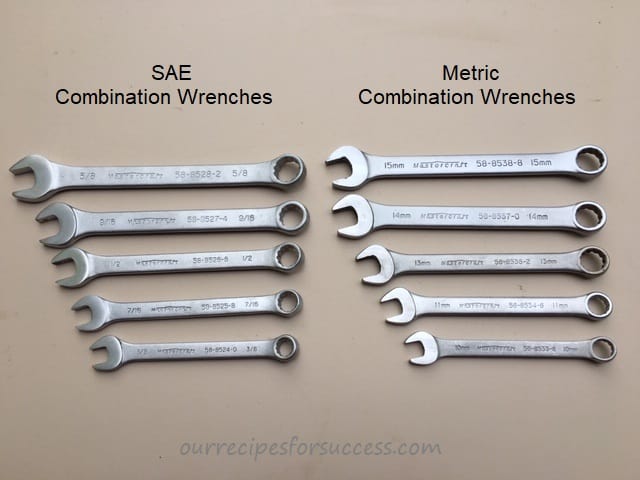
If you will be doing any kind of repairs or assembling that involves nuts and bolts, you’ll definitely want to invest in a set of combination wrenches. What is a combination wrench? It is a wrench that has one open end, that slides onto a nut, and the other end has a box end (complete circle), that has to be put on over the nut. Both ends of the wrench are the same size.
As mentioned above, wrenches fit in tight spots and allow you to tighten nuts and bolts tighter. I recommend purchasing a small set of combination wrenches from at least ⅜” up to ¾”. These will cover the majority of repairs you make around the house. If you’re doing repairs to cars, motorcycle or other recreational vehicles, you should consider buying a similarly sized set of metric wrenches too.
Ratchet And Sockets
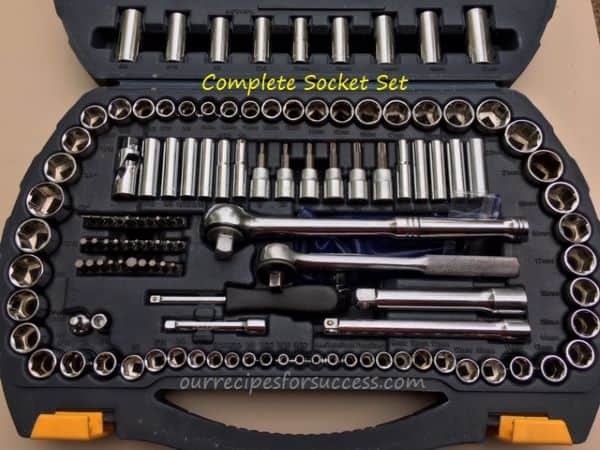
A ratchet and socket set is a great addition to any toolbox. They can reach into many locations that wrenches can’t. The ratchets come in different size “drives”. The most common are ¼”, ⅜” and ½” drives. A good starter set is the ⅜” drive ratchet and sockets, similar to my first set mentioned above. They can handle most minor repairs around the home and garage.
If you work on projects requiring more torque, the ½” ratchets would be a better choice or your the next purchase you need to consider. ½” ratchets are better suited for loosening this like lug nuts, trailer hitch balls, and larger nuts and bolts on other equipment. The combination of both ½” drive and ⅜” drive ratchets and sockets will cover most of your projects. And metric sockets use the same size drive ratchets, so be sure to have a few metric sockets on hand too.
Hex Keys
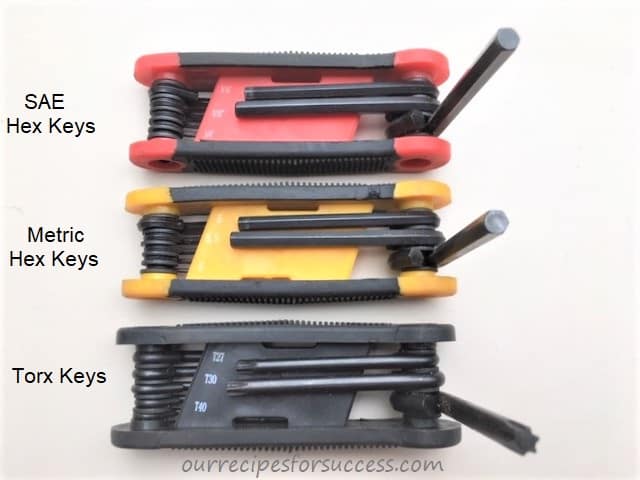
Hex keys, or wrenches, are frequently referred to as Allen wrenches. However, Allen is a brand of hex key that has been around for years. Hex key fasteners are used in all kinds of products. Often when you purchase one of these products they’ll include a hex key to help in assembly or for making adjustments. I keep these wrenches and put them in a small toolbox I keep in the house. They are good for tightening the leg on a coffee table or adjusting a door hinge around the house. However, most of the hex keys are of poorer quality and you should avoid using them important equipment.
Good quality hex keys are made of a much harder material and will hold up better when loosening or tightening hex head bolts, screws, or set screws. The less expensive, poorer quality hex keys can easily round off and slip inside the fastener causing damage to both the hex key and the fastener. For that reason, you should have a good quality set of hex keys and leave the cheap ones in the house for snugging screws and simpler tasks.
For best results using hex keys always make sure you have the correct size. Hex keys do come in metric sizes. So if you’re going to be working on cars or motorcycle, you should have a set of metric hex keys too. Make sure the key fits tightly and all the way into the fastener. You may need to clean paint, dirt, or debris out of the fastener to make this happen and keep plenty of downward pressure on the key while turning them. If the end of a hex key starts to show signs of wear from use, you can file or grind off 1/16” or ⅛” off the end of the key to revitalize it.
Torx Wrench
Along the same line as the hex key is the Torx wrench. It is recognizable by its 6 point star pattern. Torx wrenches are becoming more and more popular. I believe it is because the 6 point design has a lot more surface area and the grip their fasteners better than hex head fasteners. That allows you to put more torque on the fastener with less chance of slipping, stripping, and ruining the fastener.
Torx wrenches may not be the first tool in your toolbox, but it won’t take long for you to see their value. You’ll need them for repairs like changing your car’s air filter or adjusting the headlights. One job and they can quickly pay for themselves.
Putty Knife
Putty knives are a useful tool. Besides scraping surfaces prior to painting they can be used for so many things. Putty knives come in different widths and are made of different materials. If you’re wondering why they made my list, here are some of our most common uses.
If you’re using paint stripper a putty knife works great for removing the gooey paint. A couple of other uses for putty knives is scraping dried grass from the underside of your lawn mower deck and for cleaning the greasy mess out of the bottom of your barbecue grill. They are also perfect for spackling holes in drywall.
Conclusion
Is this the know all, end all list of tools you’ll need for all your home repairs? Absolutely not, but it’s a good list to get started with. Everybody’s needs vary. Do you have a tractor or some other larger equipment? If so, you’ll need to add some bigger wrenches and sockets. Are you going to be repairing vacuum cleaners or kitchen appliances? Better have some smaller screwdrivers and a smaller set of needle nose pliers.
Just remember no matter what you work on it can save you money and can get you out of some tough spots. There’s nothing worse than having your lawnmower die on a holiday weekend and you have family and friends coming over. With a few tools and a little research 9 times out of 10, you can be back up and running in no time. No matter what your skill level is everyone needs a basic homeowners tool kit. Start small and add a few tools as needed and soon you’ll be the envy of the neighborhood.
In another article, we’ve put together a list of basic DIY carpentry tools you will want to start adding to your homeowner’s tool kit. These tools will further expand the repairs and projects you’ll be able to take on. We invite you to check it out.
We would love to hear back from you and have you tell us what is your favorite tool in your toolkit is. Is there another tool worthy of this list? Let us know that too and tell us why. We will all benefit from your input!
If you have any comments or questions, you can leave them in the comments section below or you can email us at [email protected]. FYI, we do not collect or share email addresses. We will only use them to reply to your comments or provide answers to your questions. We are also required to let you know that some of our links are “affiliate links”. This means if you click on a link and make a purchase, we could make a small commission, at no extra cost to you. This helps offset the cost of maintaining our website. So, if you like what you’ve seen, please be sure to give us a “Like” and “Share” on Facebook and Instagram too. Thank you for reading and good luck with all your home projects!

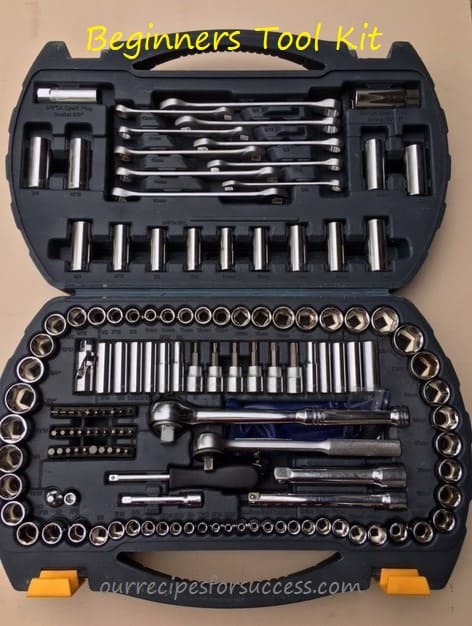
Thanks! There are a lot of repairs the average homeowner can make with just a few basic tools.
As a homeowner, I agree that we should keep a tool kit. Minor home emergencies, repair and maintenance can happen here and there. Also, the tools you mentioned are certainly essential for a basic home toolkit.